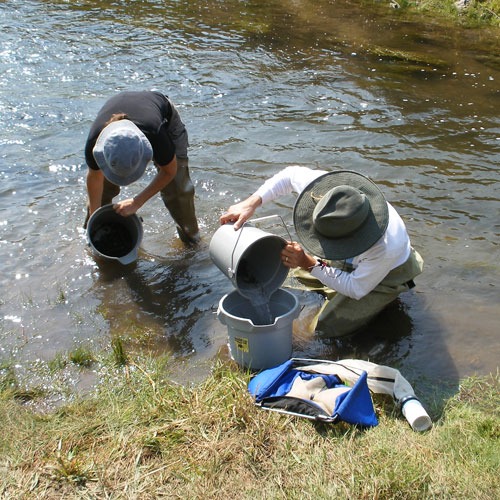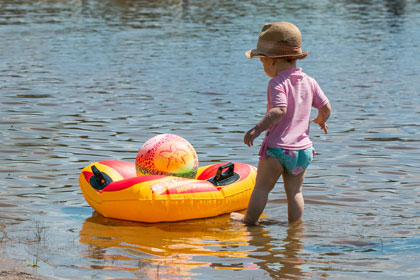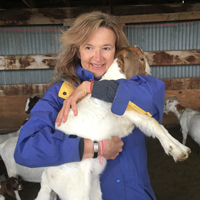
By Christine Osborne
A cool swim on a hot summer day is one of life’s simple pleasures. But water that appears to be clean may contain pathogens such as E. coli that can make people sick. The Utah Department of Environmental Quality (DEQ) wants to ensure that Utah waters are safe for swimming and other recreational activities. That’s why DEQ’s Division of Water Quality (DWQ) and local health departments (LHDs) work together to protect public health by monitoring Utah’s high-priority waterbodies for E. coli contamination. If sampling shows that E. coli levels in a waterbody exceed health standards, LHDs issue advisories to warn people not to swim in a lake or reservoir until these levels fall below the advisory threshold.
E. coli in Recreational Waters
Escherichia coli (E.coli) are a large and diverse type of bacteria commonly found in the intestines and feces of healthy people and warm-blooded animals. Many people associate E. coli with food-borne illnesses, but they can also be found in any untreated water. While most strains of E. coli are harmless, some varieties can cause diarrhea, urinary-tract infections, and even pneumonia. Surface waters containing E. coli can cause recreational water illnesses if people swallow or have contact with contaminated water.
E. coli are a good indicator of the presence of fecal contamination and possible disease-causing bacteria or viruses such as Cryptosporidium, Giardia, Shigella, and norovirus. Health officials use the presence of E. coli to determine if the public needs to be notified of a health risk, since the pathogens that accompany fecal contamination can also make the water unsafe for people.
Sources of E. coli

These wastes can enter surface waters from agricultural runoff from fields treated with manure, faulty septic tanks or sewer systems, improper dumping, waste from dogs and livestock, storm events, urban runoff, large concentrations of waterfowl or other wildlife, discharges from boats, and direct human contamination. Pollution of all kinds, including E. coli, is typically higher after rainstorms because the water flowing into streams and lakes travels over lawns, fields, sidewalks, and streets that may contribute sources of fecal contamination.
DEQ’s E. coli Monitoring Program
The Division of Water Quality (DWQ) statewide monitoring program samples for a wide range of possible contaminants, including E. coli, to determine if waters in the state are meeting water-quality standards. Water-quality data collected by DWQ are used to identify emerging problems, determine whether pollution-control programs are working, and help direct resources and pollution-control efforts to the areas where they are most needed.
While it would be ideal to collect E. coli samples on all Utah waters on a weekly basis, limited resources means DWQ must prioritize monitoring. Each year, DWQ works with local health departments to prioritize highly recreated water bodies across Utah. Utah’s high-priority recreation lakes, reservoirs, and rivers are sampled monthly during the May-through-October recreation season.
Advisories
DWQ alerts local health departments if monthly sampling indicates elevated concentrations of E. coli in waters within their jurisdiction. Likewise, local health departments notify DWQ when sampling indicates high levels of E. coli. Water quality scientists take a second sample as soon as possible after the first sample, and if the test results exceed the numeric criteria established for that waterbody, the local health department and DWQ may jointly issue a health advisory. The site is then monitored on a regular basis during the advisory. The advisory remains in place until consecutive samples over two weeks fall below the water-quality standard for the site.
How to Stay Healthy
Recreational water illnesses are spread by swallowing water, breathing in a water spray, or coming into contact with contaminated water. Swimming pools and hot tubs are treated with chemicals to kill bacteria, but most other recreational waters, including streams running through popular parks, decorative fountains, or small municipal ponds, are untreated and can pose health risks.
Follow these tips to stay safe and healthy when recreating in Utah waters:
- Don’t swallow the water.
- Make sure to wash hands if they were in contact with the water before touching the mouth or eyes. The single most effective way to prevent the person-to-person spread of E. coli is careful hand washing.
- Don’t swim in discolored, odorous, foamy, or scummy water.
- Avoid swimming within 48 hours of a major storm.
- Avoid swimming with open cuts or wounds.
- Wash and cook fish thoroughly and wash hands after handling fish or lake water.
Help protect the water from fecal contamination:
- Don’t swim in the water with diarrhea or within two weeks of having diarrhea.
- Take children for frequent bathroom breaks and diaper changes. Don’t change diapers near the water.
- Don’t rinse children off in the swimming area.
- Dispose of diapers properly away from the water.
- Pick up dog waste and dispose of it properly.
People should enjoy Utah’s beautiful lakes and streams but always be mindful of the possibility of E. coli in the water and take appropriate precautions.
Wondering if your favorite beach or pond is under a health advisory? Visit our advisories page for up-to-date information on current and past advisories. Check out our webpages to learn more about our E. coli monitoring program, sources of E. coli , and how to protect yourself when recreating in Utah waters.

I am a content strategist/communication specialist at the Utah Department of Environmental Quality. I have a Masters in Strategic Communication (MSC) degree from Westminster College and earned my Accreditation in Public Relations (APR) from the Public Relations Society of America (PRSA). I currently teach Integrated Marketing Communication to graduate students in the MSC program at Westminster. In a previous life, I was a bassoonist with the Utah Symphony for 26 years. I love to hike, bike, camp, read, garden, geek out on all things science, and spend time with two college-age sons. I volunteer with a number of local refugee organizations and am currently a teen mentor with the 4-H New American Goat Club and Teen Leadership Club.
